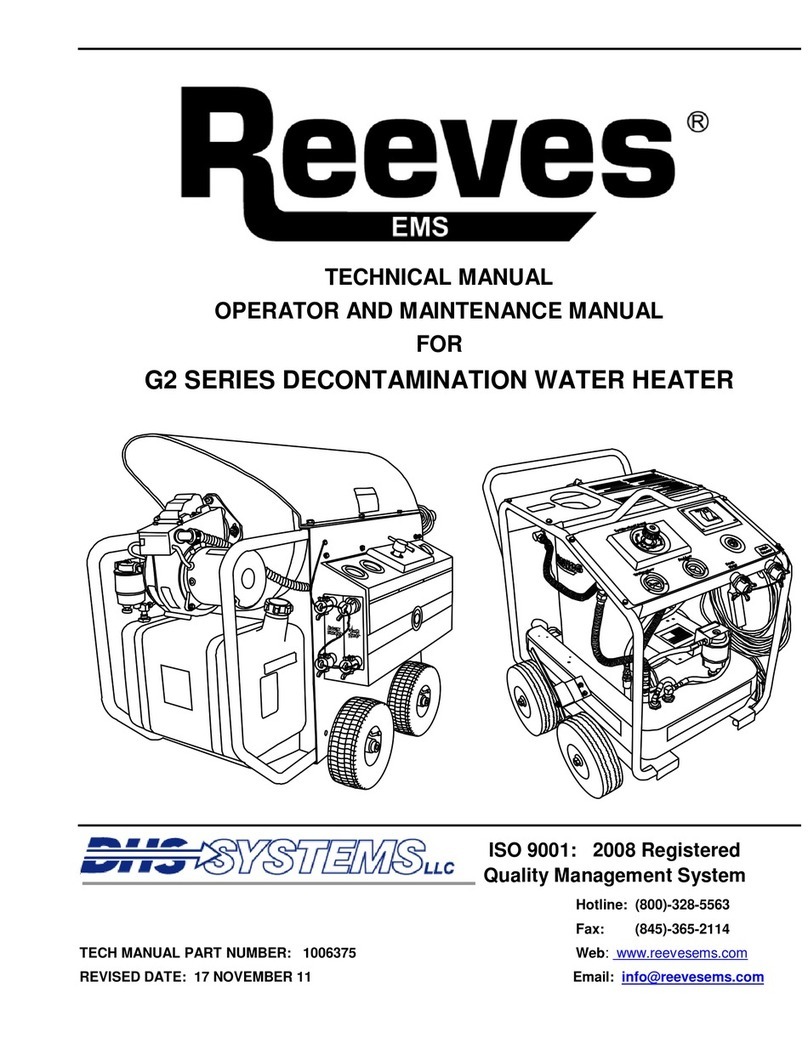
95226-01 1 REEVES EMS, LLC
This document contains information proprietary to REEVES EMS, LLC and is intended solely for use by its customers. No portion of this document may
be reproduced for release to a third party without written consent from REEVES EMS, LLC.
1 GENERAL
1.1 Scope
This Operator’s Manual describes the safe operation and field maintenance of the G2 / G2S Decontamination Water
Heater. You can be assured your hot water heater was constructed and designed with quality and performance in mind.
Each component has been rigorously tested to ensure the highest level of acceptance.
This operator’s manual was complied for your benefit. By reading and following the safety, installation, operation,
maintenance, and troubleshooting steps described in this manual, you will receive years of trouble free operation from
your new hot water heater.
1.2 Receipt of G2 / G2S Decontamination Water Heater
Once the unit has been uncrated, immediately write the model and serial number in the space provided below.
Model Number__________________ Serial Number_____________________
Inspect for signs of obvious or concealed freight damage. If damage does exist, file a claim with the transportation
company immediately. Be sure that all damaged parts are replaced and that the mechanical and electrical problems are
corrected prior to operation of the unit. If you require service, contact REEVES EMS, Customer Service. Please have the
model number and serial number available for all service calls.
1.3 Equipment Descriptions
The G2 Decontamination Water Heater is a man portable, easy to maneuver, four outlet system, with a heating output of
425,000 BTU. It also has a 6.6 gallon polyethylene decontamination solution holding tank and has the capability of
supplying hot water for one or two decontamination shelters. The G2S Decontamination Water Heater is a smaller
version of the G2 with similar features except it is a two outlet system and it doesn’t have the 6.6 gallon decontamination
solution holding tank. The G2S is capable of supplying hot water for a single shelter with a heating output of 168,000
BTU.
The G2 and G2S Water Heaters both have an enclosed fan-cooled electric motor with manual thermal overload
protection, and are capable of using No.1 or No. 2 Diesel / Kerosene for the burner. Both units have a built in Anti-Scald
Protection device and Pressure Relief Valve to protect the coils and components.
1.3.1 Solution Injector System
For best possible performance from the injector, please read this manual carefully and keep it in a safe place for further
reference. Your injector is made with high quality materials and includes the following features:
•Unit includes a non-electric, volumetric proportional injector system.
•Injector system designed to operate upon water flow.
•Built-in mixing chamber.
•Manual bypass OFF switch.
•In-line 100 micron filtration system.
•Automatic air relief valve
•Flow range: 2.6 to 660 gallons per hour (GPH).
•Injection rate: 1% (1:100) to 10% (1:10).
•Operating pressure: 6 – 100 PSI.




























